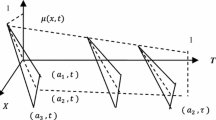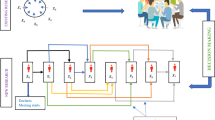Abstract
This paper deals with a backorder inventory problem under intuitionistic dense fuzzy environment. In fuzzy set theory, the concept of dense fuzzy set is quite new that depends upon the number of negotiations/turnovers made by the decision makers (DMs) of any kind of industrial setup. Moreover, we have discussed the preliminary concept on intuitionistic dense fuzzy set (IDFS) with their corresponding (non)membership functions and defuzzification methods. The graphical overview resembles the graphs obtained from a cloud aggregation model developed by Mao et al. in 2018. The basic difference is that they considered interval-valued hesitant fuzzy model with unsharp boundary but the content of present study is solely associated with nonrandom uncertainty having proper boundary. Finally, numerical examples, comparative study, sensitivity analysis, graphical illustration, and conclusion are made for justification of the new approach.

(Source: Mao et al. [38])












Similar content being viewed by others
References
Atanassov, K.T.: Intuitionistic fuzzy sets. VII ITKR’s Session, Sofia (1983)
Atanassov, K.T.: Intuitionistic fuzzy sets. Fuzzy Sets Syst. 20, 87–96 (1986)
Baez-Sancheza, A.D., Morettib, A.C., Rojas-Medarc, M.A.: On polygonal fuzzy sets and numbers. Fuzzy Sets Syst. 209, 54–65 (2012)
Ban, A.I., Coroianu, L.: Existence, uniqueness and continuity of trapezoidal approximations of fuzzy numbers under a general condition. Fuzzy Sets Syst. 257, 3–22 (2014)
Beg, I., Ashraf, S.: Fuzzy relational calculus. Bull. Malays. Math. Sci. Soc. 37(1), 203–237 (2014)
Bellman, R.E., Zadeh, L.A.: Decision making in a fuzzy environment. Manag. Sci. 17(4), 141–164 (1970)
Chutia, R., Mahanta, S., Baruah, H.K.: An alternative method of finding the membership of a fuzzy number. Int. J. Latest Trends Comput. 1, 69–72 (2010)
Das, P., De, S.K., Sana, S.S.: An EOQ model for time dependent backlogging over idle time: a step order fuzzy approach. Int. J. Appl. Comput. Math. (2014). https://doi.org/10.1007/s40819-014-0001-y
Deli, I., Broumi, S.: Neutrosophic soft matrices and NSM-decision making. J. Intell. Fuzzy Syst. 28(5), 2233–2241 (2015)
De, S.K., Beg, I.: Triangular dense fuzzy neutrosophic sets. Neutrosophic Sets Syst. 13, 1–12 (2016)
De, S.K., Beg, I.: Triangular dense fuzzy sets and new defuzzication methods. J. Intell. Fuzzy Syst. (2016). https://doi.org/10.3233/IFS-162160
De, S.K.: EOQ model with natural idle time and wrongly measured demand rate. Int. J. Inventory Control Manag. 3(1–2), 329–354 (2013)
De, S.K., Goswami, A., Sana, S.S.: An interpolating by pass to Pareto optimality in intuitionistic fuzzy technique for an EOQ model with time sensitive backlogging. Appl. Math. Comput. 230, 664–674 (2014)
De, S.K., Mahata, G.C.: A cloudy fuzzy economic order quantity model for imperfect-quality items with allowable proportionate discounts. J. Ind. Eng. Int. (2019). https://doi.org/10.1007/s40092-019-0310-1
De, S.K., Mahata, G.C.: A comprehensive study of an economic order quantity model under fuzzy monsoon demand. Sadhana. (2019). https://doi.org/10.1007/s12046-019-1059-3
De, S.K., Mahata, G.C.: Decision of a fuzzy inventory with fuzzy backorder model under cloudy fuzzy demand rate. Int. J. Appl. Comput. Math. (2016). https://doi.org/10.1007/s40819-016-0258-4
De, S.K., Pal, M.: An intelligent decision for a bi-objective inventory problem. Int. J. Syst. Sci. Oper. Logists. (2015). https://doi.org/10.1080/23302674.2015.1043363
De, S.K., Sana, S.S.: An EOQ model with backlogging. Int. J. Manag. Sci. Eng. Manag. (2015). https://doi.org/10.1080/17509653.2014.995736
De, S.K., Sana, S.S.: Backlogging EOQ model for promotional effort and selling price sensitive demand—an intuitionistic fuzzy approach. Ann. Oper. Res. (2013). https://doi.org/10.1007/s10479-013-1476-3
De, S.K., Sana, S.S.: Fuzzy order quantity inventory model with fuzzy shortage quantity and fuzzy promotional index. Econ. Model. 31, 351–358 (2013)
De, S.K., Sana, S.S.: The (p, q, r, l) model for stochastic demand under intuitionistic fuzzy aggregation with Bonferroni mean. J. Intell. Manuf. (2016). https://doi.org/10.1007/s10845-016-1213-2
De, S.K.: Triangular dense fuzzy lock set. Soft. Comput. (2017). https://doi.org/10.1007/s00500-017-2726-0
Dubois, D., Prade, H.: Operations on fuzzy numbers. Int. J. Syst. Sci. 9(6), 613–626 (1978)
Ejegwa, P.A., Akubo, A.J., Joshua, O.M.: Intuitionistic fuzzy set and its application in career determination via normalized euclidean distance method. Eur. Sci. J. 10(15), 529–536 (2014)
Heilpern, S.: Fuzzy mappings and fixed-point theorem. J. Math. Anal. Appl. 83, 566–569 (1981)
Karmakar, S., De, S.K., Goswami, A.: A pollution sensitive dense fuzzy economic production quantity model with cycle time dependent production rate. J. Clean. Prod. 154, 139–150 (2017)
Karmakar, S., De, S.K., Goswami, A.: A pollution sensitive remanufacturing model with waste items: triangular dense fuzzy lock set approach. J. Clean. Prod. (2018). https://doi.org/10.1016/j.jclepro.2018.03.161
Kaufmann, A., Gupta, M.M.: Introduction of fuzzy arithmetic theory and applications. Van Nostrand Reinhold, New York (1985)
Kaur, A., Kumar, A., Appadoo, S.S.: A note on “approaches to interval intuitionistic trapezoidal fuzzy multiple attribute decision making with incomplete weight information”. Int. J. Fuzzy Syst. (2019). https://doi.org/10.1007/s40815-018-0581-5
Kazemi, N., Ehsani, E., Jaber, M.: An inventory models with backorders with fuzzy parameters and decision variables. Int. J. Approx. Reason. 51(8), 964–972 (2010)
Kazemi, N., Olugu, E.U., Salwa Hanim, A.-R., Ghazilla, R.A.B.R.: Development of a fuzzy economic order quantity model for imperfect quality items using the learning effect on fuzzy parameters. J. Intell. Fuzzy Syst. 28(5), 2377–2389 (2015)
Kazemi, N., Olugu, E.U., Salwa Hanim, A.-R., Ghazilla, R.A.B.R.: A fuzzy EOQ model with backorders and forgetting effect on fuzzy parameters: an empirical study. Comput. Ind. Eng. 96, 140–148 (2016)
Liang, R., Wang, J.Q.: A linguistic intuitionistic cloud decision support model with sentiment analysis for product selection in E-commerce. Int. J. Fuzzy Syst. (2019). https://doi.org/10.1007/s40815-019-00606-0
Maity, S., Chakraborty, A., De, S.K., Mondal, S.P., Alam, S.: A comprehensive study of a backlogging EOQ model with nonlinear heptagonal dense fuzzy environment. RAIRO-Oper. Res. (2018). https://doi.org/10.1051/ro/201811
Maity, S., De, S.K., Mondal, S.P.: A study of an EOQ model under Lock Fuzzy Environment. Mathematics. (2019). https://doi.org/10.3390/math7010075
Maity, S., De, S.K., Pal, M.: Two decision makers’ single decision over a back order EOQ model with dense fuzzy demand rate. Financ. Mark. 3, 1–11 (2018)
Mahanta, S., Chutia, R., Baruah, H.K.: Fuzzy arithmetic without using the method of α-cuts. Int. J. Latest Trends Comput. 1, 73–80 (2010)
Mao, X.B., Hu, S.S., Dong, J.Y., Wan, S.P., Xu, G.L.: Multi-attribute group decision making based on cloud aggregation operators under interval valued hesitant fuzzy linguistic environment. Int. J. Fuzzy Syst. (2018). https://doi.org/10.1007/s40815-018-0495-2
Piegat, A.: A new definition of fuzzy set. Appl. Math. Comput. Sci. 15(1), 125–140 (2005)
Roychoudhury, S., Pedrycz, W.: An alternative characterization of fuzzy complement functional. Soft Comput. Fusion Found. Methodol. Appl. 7, 563–565 (2003)
Singh, S., Shreevastava, S., Som, T., Jain, P.: Intuitionistic fuzzy quantifier and its application in feature selection. Int. J. Fuzzy Syst. (2019). https://doi.org/10.1007/s40815-018-00603-9
Wright, I.P.: Factors affecting the cost of airplanes. J. Aeronaut. Sci. 3, 122–128 (1936)
Wu, P., Zhou, L., Chen, H., Tao, Z.: Additive consistency of hesitant fuzzy linguistic preference relation with a new expansion principle for hesitant fuzzy linguistic term sets. IEEE Trans. Fuzzy Syst. 27(4), 716–730 (2019)
Zadeh, L.A.: Fuzzy sets. Inf. Control 8(3), 338–356 (1965)
Acknowledgements
The authors are grateful to the anonymous reviewers for their valuable comments and suggestions to improve the quality of this article.
Author information
Authors and Affiliations
Corresponding author
Ethics declarations
Conflict of interest
The authors declare that there are no conflicts of interest regarding the publication of this article.
Rights and permissions
About this article
Cite this article
Maity, S., De, S.K. & Mondal, S.P. A Study of a Backorder EOQ Model for Cloud-Type Intuitionistic Dense Fuzzy Demand Rate. Int. J. Fuzzy Syst. 22, 201–211 (2020). https://doi.org/10.1007/s40815-019-00756-1
Received:
Revised:
Accepted:
Published:
Issue Date:
DOI: https://doi.org/10.1007/s40815-019-00756-1




